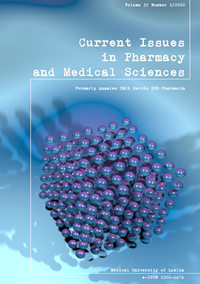Coumarin derivatives against amyloid-beta 40 – 42 peptide andtauprotein
DOI:
https://doi.org/10.2478/cipms-2022-0013Keywords:
neurodegeneration, coumarins, tau, Aβ40/42, in vitro, in celluloAbstract
In preclinical studies, simple coumarins (scoparone, limettin) and furanocoumarins (imperatorin, xanthotoxin, bergapten) have already found to demonstrate procognitive abilities. This suggests that they hold antioxidative, anti-inflammatory and inhibitory action towards acetylcholinesterase activities. However, little is known about their influence on the amyloidal structure formation, the leading cause of Alzheimer’s disease (AD).In vitroandin celluloassays were applied to evaluate the effect of selected coumarins on the different stages of Aβ40/42 andtauprotein aggregation. Kinetic analyses were performed to evaluate their inhibiting abilities in time. Limettin revealed the most potent inhibiting profile towards Aβ40 aggregation, however, all tested compounds presented low influence on Aβ42 and tau protein aggregation inhibition. Despite the preliminary stage of the project, the promising effects of coumarins on Aβ40 aggregation were shown. This suggests the coumarin scaffold can serve as a potential multitarget agent in AD treatment, but further studies are required to confirm this.
References
1. Serrano-Pozo A, Das S, Hyman BT. APOE and Alzheimer’s disease: Advances in genetics, pathophysiology, and therapeutic approaches.Lancet Nerol. 2021;20(1):68-80.
2. Hardy J, Selkoe DJ. The amyloid hypothesis of Alzheimer’s disease: progress and problems on the road to therapeutics. Science. 2002; 297:353-6.
3. Dasari M, Espargaro A, Sabate R, Lopez Del Amo JM, Fink U, Grelle G, et al. Bacterial inclusion bodies of Alzheimer’s disease β-amyloid peptides can be employed to study native-like aggregation intermediate states. Chembiochem. 2011;12:407-23.
4. Mao P, Reddy PH. Aging and amyloid beta-induced oxidative DNA damage and mitochondrial dysfunction in Alzheimer’s disease: implications for early intervention and therapeutics. Biochim Biophys Acta. 2011;1812:1359-70.
5. Govoni S, Mura E, Preda S, Racchi M, Lanni C, Grilli M, et al. Dangerous liaisons between beta-amyloid and cholinergic neurotransmission. Curr Pharm Des. 2014;20:2525-38.
6. Tang BL. Amyloid Precursor Protein (APP) and GABAergic neurotransmission. Cells. 2019;8:550.
7. Girek M, Szymański P. Tacrine hybrids as multi-target-directed ligands in Alzheimer’s disease: influence of chemical structures on biological activities. Chem Papers. 2018;73:269-89.
8. Morphy R, Rankovic Z. Designed multiple ligands. An emerging drug discovery paradigm. J Med Chem. 2005;48:6523-43.
9. Skalicka-Woźniak K, Orhan IE, Cordell GA, Nabavi SM, Budzyńska B. Implication of coumarins towards central nervous system disorders. Pharmacol Res. 2016;103:188-203.
10. Rao VR. Antioxidant Agents. Advances in structure and activity relationship of coumarin derivatives. London; 2016:137-50.
11. Wang L, Yin YL, Liu XZ, Shen P, Zheng YG, Lan XR, et al. Current understanding of metal ions in the pathogenesis of Alzheimer’s disease. Transl Neurodegener. 2020;9 :10.
12. Budzynska B, Boguszewska-Czubara A, Kruk-Slomka M, Skalicka-Wozniak K, Michalak A, Musik I, et al. Effects of imperatorin on scopolamine-induced cognitive impairment and oxidative stress in mice. Psychopharmacology (Berl). 2015;232:931-42.
13. Espargaró A, Medina A, di Pietro O, Muñoz-Torrero D, Sabate R. Ultra rapid in vivo screening for anti-Alzheimer anti-amyloid drugs. Scientific Reports. 2016;6:1-8.
14. Kowalczyk J, Budzyńska B, Kurach Ł, Pellegata D, Sayed NS, Gertsch J, et al. Neuropsychopharmacological profiling of scoparone in mice. Sci Rep. 2022;12:822.
15. Kozioł E, Skalicka-Woźniak K. Imperatorin–pharmacological meaning and analytical clues: profound investigation. Phytochem Rev. 2016;15:627-49.
16. Espargaró A, Sabaté R, Ventura S. Kinetic and thermodynamic stability of bacterial intracellular aggregates. FEBS Letters. 2008;582: 3669-73.
17. Espargaró A, Pont C, Gamez P, Muñoz-Torrero D, Sabate R. Amyloid pan-inhibitors: One family of compounds to cope with all conformational diseases. ACS Chem Neurosci. 2019;10:1311-7.
18. Lue LF, Kuo YM, Roher AE, Brachova L, Shen Y, Sue L, et al. Soluble amyloid β peptide concentration as a predictor of synaptic change in Alzheimer’s disease. Am J Pathol. 1999;155:853-62.
19. Walsh DM, Klyubin I, Fadeeva JV, Cullen WK, Anwyl R, Wolfe MS, et al. Naturally secreted oligomers of amyloid beta protein potently inhibit hippocampal long-term potentiation in vivo. Nature. 2002;416:535-9.
20. Li JJ, Dolios G, Wang R, Liao FF. Soluble beta-amyloid peptides, but not insoluble fibrils, have specific effect on neuronal microRNA expression. PLoS One. 2014;9(3):e90770.
21. Yang J, Zhu B, Yin W, Han Z, Zheng C, Wang P, et al. Differentiating Aβ40 and Aβ42 in amyloid plaques with a small molecule fluorescence probe. Chem Sci. 2020;11:5238-45.
22. Gu L, Guo Z. Alzheimer’s Aβ42 and Aβ40 peptides form interlaced amyloid fibrils. J Neurochem. 2013;126:305.
23. Takomthong P, Waiwut P, Yenjai C, Sripanidkulchai B, Reubroycharoen P, Lai R, et al. Structure-activity analysis and molecular docking studies of coumarins from Toddalia asiatica as multifunctional agents for Alzheimer’s disease. Biomedicines. 2020;8(5):107.
Downloads
Published
Issue
Section
License
Copyright (c) 2022 Authors

This work is licensed under a Creative Commons Attribution-NonCommercial-NoDerivatives 3.0 Unported License.


